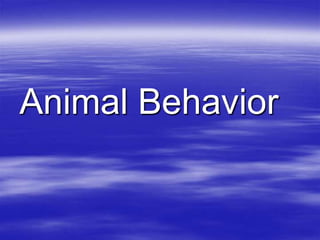
Learned Behaviors.ppt
- 2. Learned Behaviors Behaviors animals are NOT born with Acquired / Modified by experience Behaviors are learned from observations and experience Often learned from parents
- 3. Types of Learned Behavior Non-Associative Learning Habituation Sensitization Associative Learning Classical Conditioning Operant Conditioning (Trial and Error) Latent Learning Imprinting Insight (Reasoning)
- 4. Non-Associative Leaning Organisms change their response to a stimuli without association with a positive or negative reinforcement. 2 Types: 1. Habituation 2. Sensitization
- 5. Habituation A decrease in response to a stimulus after repeat exposure Less sensitive to stimuli Eliminates responses that have no value on an animals survival or welfare. Helps prevent waste of energy
- 6. Sensitization The increase that occurs in an organism’s responsiveness to stimuli following an especially intense or irritating stimulus. More sensitive to stimuli Depending on the intensity and duration of the original stimulus, the period of increased responsiveness can last from several seconds to several days.
- 7. Classical Conditioning Experiment by Ivan Pavlov Pavlov began to observe salivation in dogs 1. He would enter the room and place meat powder or a food morsel on tongue and wait for salivation to occur 2. He began to see that the dogs were salivating as soon as he entered the room, which was before any food was even in sight. 3. The dogs became conditioned by Pavlov to have expectations. When he entered the room, the dogs expected food; therefore, they began salivating in expectation
- 8. Neutral Stimulus A neutral stimulus is something that normally would not produce any salivation Pavlov chose to ring a bell since ringing a bell would not normally produce salivation in the dogs. Pavlov began ringing a bell before placing the meat powder or item on the dog's tongue Each and every time that the bell was rung, meat powder or food was given to the dog. Pavlov repeated these experiments many, many times. Eventually, the bell alone was enough to make the dogs salivate. The dog had learned to associate the sound of the bell with food.
- 10. Unconditioned Stimulus Stimulus that leads to a response with NO training Ex. Food
- 11. Conditioned Stimulus A former neutral stimulus that comes to elicit a given response after pairing with an unconditioned stimulus. Ex. Bell
- 12. Unconditioned Response Automatic Response to an unconditioned stimulus. Ex. Salivate
- 13. Conditioned Response A learned response to a conditioned stimulus. Ex. Salivate
- 14. What did this prove? Pavlov's experiment proved that all animals could be trained or conditioned to expect a consequence on the results of previous experience.
- 15. Operant Conditioning an unassociated behavior becomes associated with a reward B.F. Skinner designed an apparatus called a "Skinner box" to test the interaction between UCS and CS
- 16. Skinner Box A rat was placed inside the Skinner box If the rat pressed down a lever inside the box then the box would release a food pellet Soon, the rat pressed the lever far more often than he would just by chance. But with each instance of lever pressing, the operant is reinforced by reward with food. The rat learns that pressing the lever is associated with food, and so he will increasingly press it.
- 17. Training Rats in a Skinner Box
- 18. Classical vs. Operant In classical conditioning, the animal receives no benefit from associating the CS with the UCS.
- 19. Latent Learning When an organism learns something in its life, but the knowledge is not immediately expressed. Knowledge remains dormant until certain circumstances allow or require it to be expressed Learning WITHOUT REWARDS! No association with a positive or negative stimulus.
- 20. Example of Latent Learning Place a rat in a maze with no food The rat will simply run around the maze, familiarizing itself with the surroundings. If you then return the rat to the same maze the next day and add food, the rat will find the food much more quickly then will a rat placed in the maze with food for the first time.
- 21. Imprinting Process by which a social attachment to a particular object is formed during a critical time period. Critical Time Period: Prior to birth to somewhere around 30 hr old Early in life when recognition is critical
- 22. Insight Learning Type of learning or problem solving that happens all-of-a-sudden. Prior experience is crucial to learning Investigations are difficult because the learning happens quickly
- 23. Learning Ability of Domestic Animals What learning is possible for domestic animals? Observations of behaviour and experimental studies of learning show that they can, for example, learn to: navigate in their environment, distinguish the qualities of food, return to food sources, avoid physical dangers, minimize predation risk, discriminate individual animals and respond differentially to individuals according to previously acquired information. Studies indicating such abilities are described.
- 24. Observations of learning in the real world, which domestic animals encounter, offer the most impressive evidence of their ability. Pet-owners are familiar with the abilities of their animals to learn how to get food and other resources in their daily lives. sheep and cattle are very selective about what they eat and they have to learn about all the different plants they encounter.